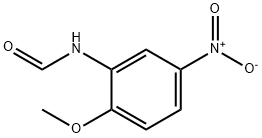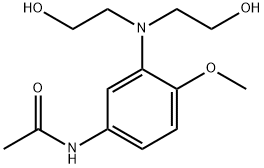2,4-DIAMINOANISOLE
Synonym(s):4-Methoxy-m-phenylenediamine
- CAS NO.:615-05-4
- Empirical Formula: C7H10N2O
- Molecular Weight: 138.17
- MDL number: MFCD00007803
- EINECS: 210-406-1
- SAFETY DATA SHEET (SDS)
- Update Date: 2025-06-13 14:48:16

What is 2,4-DIAMINOANISOLE?
Description
2,4-Diaminoanisole is a needle-like solid.Molecular weight = 138.19; Freezing/Melting point67-68℃. The sulfate is an off-white to violet powder.Hazard Identification (based on NFPA-704 M RatingSystem): Health 3, Flammability 0, Reactivity 0 (includessulfate). Soluble in water.
Chemical properties
2,4-Diaminoanisole is a needle-like solid.
The Uses of 2,4-DIAMINOANISOLE
2,4-Diaminoanisole may be used as an analytical reference standard for the determination of the analyte in:
- Mainstream waterpipe smoke using liquid chromatography-electrospray ionization-tandem mass spectrometry (LC-ESI-MS/MS).
- Haircolor products by high performance liquid chromatography (HPLC).
Definition
ChEBI: 2,4-Diaminoanisole is a member of methoxybenzenes.
General Description
Colorless needles. Primarily used (along with salts such as 2,4-DIAMINOANISOLE sulfate) as a component of hair & fur dye formulations.
Reactivity Profile
2,4-DIAMINOANISOLE is incompatible with the following: Strong oxidizers .
Safety Profile
Confirmed carcinogen. Poison by intraperitoneal route. Moderately toxic by ingestion. Experimental reproductive effects. Human mutation data reported. A skin irritant. When heated to decomposition it emits toxic fumes of NOx. See also other diaminoanisole entries.
Potential Exposure
The principal use of 2,4-diamino-ani- sole (and its salts such as the sulfate) as a component of oxidation (permanent) hair and fur dye formulations. Human exposure to 2,4-diaminoanisole sulfate may possibly occur through skin absorption at chemical and dye production facilities, as well as through dermal contact in persons using hair dyes containing the chemical.
First aid
If this chemical gets into the eyes, remove anycontact lenses at once and irrigate immediately for at least15 min, occasionally lifting upper and lower lids. Seekmedical attention immediately. If this chemical contactsthe skin, remove contaminated clothing and wash immediately with soap and water. Seek medical attention immediately. If this chemical has been inhaled, remove fromexposure, begin rescue breathing (using universal precautions, including resuscitation mask) if breathing hasstopped and CPR if heart action has stopped. Transferpromptly to a medical facility. When this chemical hasbeen swallowed, get medical attention. Give large quantities of water and induce vomiting. Do not make an unconscious person vomit.
Storage
Color Code—Blue: Health Hazard/Poison: Storein a secure poison location. Prior to working with 2,4-DAAsulfate you should be trained on its proper handling andstorage. A regulated, marked area should be establishedwhere this chemical is handled, used, or stored in compliance with OSHA Standard 1910.1045. Store in tightlyclosed containers in a cool, well-ventilated area away fromaluminum and magnesium.
Shipping
UN2811 Toxic solids, organic, n.o.s., Hazard Class: 6.1; Labels: 6.1-Poisonous materials, Technical Name Required. UN3143 Dyes, solid, toxic, n.o.s. or Dye intermediates, solid, toxic, n.o.s., Hazard Class: 6.1; Labels: 6.1-Poisonous materials, Technical Name Required.
Incompatibilities
Incompatible with strong oxidizers (chlorates, nitrates, peroxides, permanganates, perchlorates, chlorine, bromine, fluorine, etc.); contact may cause fires or explosions. Keep away from alkaline materials, strong bases, strong acids, oxoacids, and epoxides. The sulfate may react violently with aluminum and magnesium.
Waste Disposal
Dissolve or mix the material with a combustible solvent and burn in a chemical incinera- tor equipped with an afterburner and scrubber. All federal, state, and local environmental regulations must be observed .
Properties of 2,4-DIAMINOANISOLE
| Melting point: | 67.5°C |
| Boiling point: | 253.57°C (rough estimate) |
| Density | 1.1315 (rough estimate) |
| refractive index | 1.5200 (estimate) |
| solubility | Chloroform (Slightly), DMSO (Slightly), Methanol (Very Slightly) |
| Colour Index | 76050 |
| pka | 5.19±0.10(Predicted) |
| form | neat |
| BRN | 2085522 |
| CAS DataBase Reference | 615-05-4(CAS DataBase Reference) |
| IARC | 2B (Vol. Sup 7, 79) 2001 |
| NIST Chemistry Reference | 1,3-Benzenediamine, 4-methoxy-(615-05-4) |
| EPA Substance Registry System | 2,4-Diaminoanisole (615-05-4) |
Safety information for 2,4-DIAMINOANISOLE
| Signal word | Danger |
| Pictogram(s) |
 Exclamation Mark Irritant GHS07  Health Hazard GHS08  Environment GHS09 |
| GHS Hazard Statements |
H302:Acute toxicity,oral H341:Germ cell mutagenicity H350:Carcinogenicity H411:Hazardous to the aquatic environment, long-term hazard |
| Precautionary Statement Codes |
P201:Obtain special instructions before use. P273:Avoid release to the environment. P308+P313:IF exposed or concerned: Get medical advice/attention. |
Computed Descriptors for 2,4-DIAMINOANISOLE
New Products
4,4-Difluoropiperidine hydrochloride tert-butyl 9-methoxy-3-azaspiro[5.5]undecane-3-carboxylate Indole Methyl Resin N-Isopropylurea N,N-Dicyclohexylcarbodiimide(DCC) MELDRUMS ACID 5-METHYLISOXAZOLE-4-CARBOXYLIC ACID Magnessium Bis glycinate Zinc ascorbate 1-bromo-2-butyne 2-acetamidophenol 9(10H)-anthracenone Erythrosin B, 4-Piperidinopiperidine 2-((4-morpholinophenylamino) (methylthio) methylene) malononitrile 2,4-dihydroxybenzaldehyde 3-(4-morpholinophenylamino)-5-amino-1H-pyrazole-4-carbonitrile Methyl 2-methylquinoline-6-carboxylate 2,6-dichloro-4-nitropyridine 4-Bromo-2-chlorobenzonitrile 2-(benzylamino)acetic acid hydrochloride 4-(tert-Butoxycarbonylamino)but- 2-ynoic acid 3,4-dihydro-2H-benzo[b][1,4]dioxepine 1-Phenyl-1-cycloprppanecarboxylicacidRelated products of tetrahydrofuran



![N-[3-[(2-Cyanoethyl)ethylamino]-4-methoxyphenyl]acetamide](https://img.chemicalbook.in/CAS/GIF/19433-94-4.gif)




You may like
-
 2,4-Diaminoanisole CAS 615-05-4View Details
2,4-Diaminoanisole CAS 615-05-4View Details
615-05-4 -
 3-(4-amino-1-oxoisoindolin-2-yl)-1-methylpiperidine-2,6-dione 98%View Details
3-(4-amino-1-oxoisoindolin-2-yl)-1-methylpiperidine-2,6-dione 98%View Details -
 614-19-7 98%View Details
614-19-7 98%View Details
614-19-7 -
 3112-85-4 Methyl phenyl sulfone 98%View Details
3112-85-4 Methyl phenyl sulfone 98%View Details
3112-85-4 -
 20677-73-0 (2,2-diethoxyethyl)methylamine 98%View Details
20677-73-0 (2,2-diethoxyethyl)methylamine 98%View Details
20677-73-0 -
 3-(4-(hydroxyamino)-1-oxoisoindolin-2-yl)piperidine-2,6-dione 98%View Details
3-(4-(hydroxyamino)-1-oxoisoindolin-2-yl)piperidine-2,6-dione 98%View Details -
 57381-49-4 2-bromo-4-chlorobenzonitrile 98%View Details
57381-49-4 2-bromo-4-chlorobenzonitrile 98%View Details
57381-49-4 -
 4,6-dichloropyrimidine-5-carbaldehyde 98%View Details
4,6-dichloropyrimidine-5-carbaldehyde 98%View Details
5305-40-8
